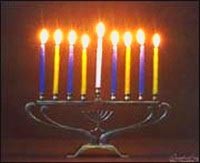Celebration of Hanukkah Begins

 Hanukkah, the Jewish festival of rededication, also known as the festival of lights, is an eight-day festival beginning on the 25th day of the Jewish month of Kislev.
Hanukkah, the Jewish festival of rededication, also known as the festival of lights, is an eight-day festival beginning on the 25th day of the Jewish month of Kislev.
The story of Hanukkah begins in the reign of Alexander the Great. Alexander conquered Syria, Egypt and Palestine, but allowed the lands under his control to continue observing their own religions and retain a certain degree of autonomy. Under this relatively benevolent rule, many Jews assimilated much of Hellenistic culture, adopting the language, the customs and the dress of the Greeks, in much the same way that Jews in America today blend into the secular American society.
More than a century later, Antiochus IV, a successor of Alexander, was in control of the region. He began to oppress the Jews severely, placing a Hellenistic priest in the Temple, massacring Jews, prohibiting the practice of the Jewish religion, and desecrating the Temple by requiring the sacrifice of pigs (a nonkosher animal) on the altar. Two groups opposed Antiochus: a basically nationalistic group led by Mattathias the Hasmonean and his son Judah Maccabee and a religious traditionalist group known as the Chasidim, the forerunners of the Pharisees (no direct connection to the modern movement known as Chasidism). They joined forces in a revolt against both the assimilation of the Hellenistic Jews and oppression by the Seleucid Greek government. The revolution succeeded and the Temple was rededicated.
According to tradition as recorded in the Talmud, at the time of the rededication, there was very little oil left that had not been defiled by the Greeks. Oil was needed for the menorah (candelabrum) in the Temple, which was supposed to burn throughout the night every night. There was only enough oil to burn for one day, yet miraculously, it burned for eight days, the time needed to prepare a fresh supply of oil for the menorah. An eight-day festival was declared to commemorate this miracle. Note that the holiday commemorates the miracle of the oil, not the military victory: Jews do not glorify war.
The only religious observance related to the holiday is the lighting of candles. The candles are arranged in a candelabrum called a menorah (or sometimes called a hanukiah) that holds nine candles: one for each night, plus a shammus (servant) at a different height. On the first night, one candle is placed at the far right. The shammus candle is lit and three berakhot (blessings) are recited: l'hadlik neir (a general prayer over candles), she-asah nisim (a prayer thanking for performing miracles for our ancestors at this time), and she-hekhianu (a general prayer thanking G-d for allowing us to reach this time of year). After reciting the blessings, the first candle is then lit using the shammus candle, and the shammus candle is placed in its holder. The candles are allowed to burn out on their own after a minimum of half an hour.
Each night, another candle is added from right to left (like the Hebrew language). Candles are lit from left to right (because you pay honor to the newer thing first). On the eighth night, all nine candles (the eight Chanukkah candles and the shammus) are lit. See animation at right for the candlelighting procedure. On nights after the first, only the first two blessings are recited; the third blessing, she-hekhianu is only recited on the first night of holidays.









